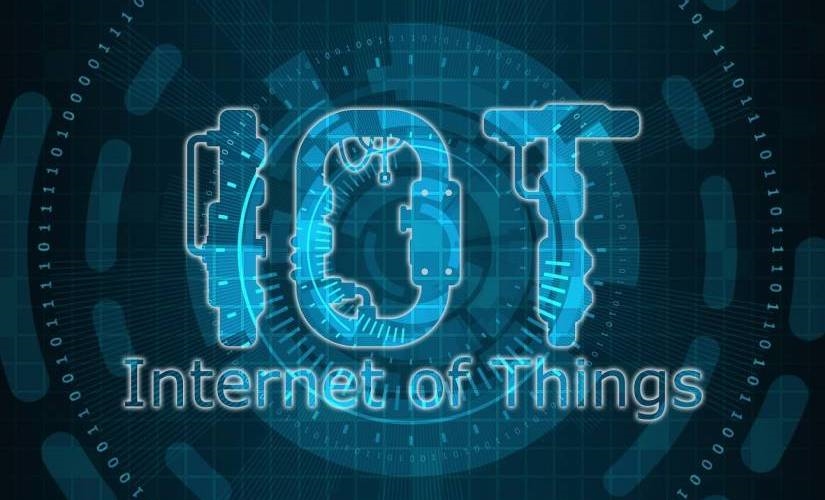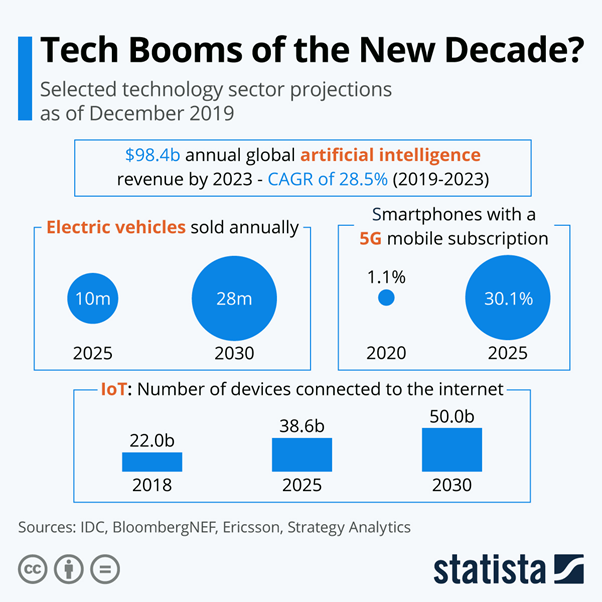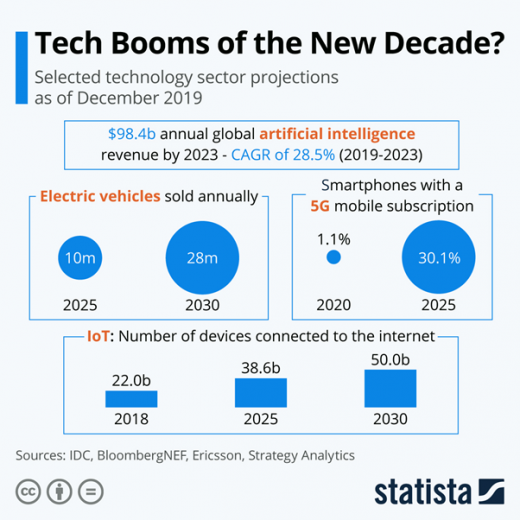Take a Bow Millennials: The IoT is a Reality Thanks to You
Take a Bow Millennials: The IoT is a Reality Thanks to You

It’s not that millennials came up with the idea of IoT. If we look at the history of IoT, we were tinkering with connected machines from the early nineties. Aside from a few precocious tweens, most millennials were still learning at school rather than making waves in IoT. “IoT is a reality” — this trend is finally becoming true. Dreamed of by computer nerds everywhere for decades, we’re finally seeing a fully connected world. And, while millennials take a lot of flack for other things, here they get all the credit.
Let’s Understand the History
However, the technology at the time was hopelessly inadequate. No one could’ve made those now-antiquated systems operable. Do you remember Cellnet? Probably not. Hardly anyone does. Compared to today’s technology, it was low in bandwidth and completely insecure. Even a baby boomer could hack those networks today.
What sets millennials apart here, however, is that they grew up knowing that the IoT would be a reality. Baby Boomers watched sci-fi shows like Star Trek, and these sparked some ideas, perhaps. At the end of the day, everyone knew that such technologies belonged to the realm of science fiction.
Millennials, on the other hand, grew up as Trekkies started to make some of those futuristic creations a reality. The Star Trek crew walked around with hand-held or touch-activated communicators and scanners. You could locate someone using their communicators. The medical team would use the scanners to read biometric data.
We all carry a similar, albeit more basic, form of this technology in our mobile phones and biometric scanners today. Baby boomers were the dreamers. Millennials saw the fruition of some of those dreams and so became believers.
And while IoT adoption was slower than most believed, the big players committed to improving the infrastructure. Dell pledged $ 1 billion in 2017 to the future of the IoT to become a reality. Google, Amazon, and Apple also all invested heavily in IoT at the time.
The Situation As It Stands Now
Just three years later, the situation is very different. We now have smart speakers, thermostats, security systems, cars, and many more smart devices.
According to industry projections at the end of 2019, the reality of IoT is one of the new decade’s tech booms. The number of connected devices should hit the 50 billion mark by 2030.

Source: Statista
That’s an average of seven devices for every person globally, and a stark rise from the 2018 average of about three per person.
There’s a buzz around the IoT, and it’s not going away anytime soon. And we have millennials to thank for that.
Why Millennials?
Representing <a href=”https://teamstage.io/millennials-in-the-workplace-statistics/”>75% of the global workforce by 2025</a>, millennials are the force to be reckoned with.
They were the early adopters and chose to stay connected. This generation was the one hardest hit by the subprime lending crisis in 2008. They’ve learned the value of a shared economy.
They’re now one of the primary economic forces globally. And that means they’re in a prime position to ensure that their IoT goals are met. They’re the ones that are driving many of the SaaS, PaaS, and IaaS solutions that we see today.
The IoT is a big part of the new sharing economy, so it’ll endure.
IoT Reality-How the Sharing Economy Is Changing the World
Another example of the sharing economy is asset accumulation. For the baby boomers, owning your car and house was a status symbol to achieve.
Today’s nouveau riche prefers to pay for what they use rather than acquire an asset outright. They buy assets that they can earn an income through. They no longer, however, invest in depreciating assets any longer.
IoT plays an essential role in the pay as you use model. Someone running an Airbnb property, for example, can use digital locks. They provide the password to the new users. When the person leaves, they generate a new code.
Up-and-coming young people may also choose the pay-as-you-go model for service reasons. IoT technologies built into a vehicle, for example, may monitor driving performance. Those that drive more carefully might receive preferable rates going forward.
Owners may track vehicles and detect when there’s a break-down or collision. They could dispatch emergency services or roadside assistance immediately. These are little things that provide additional benefits. The system may remind them to stop at a gas station or report for a maintenance check.
Naturally, there are concessions to make. Should they drive poorly, they’ll pay extra for your rental.
Still, considering the immediate drop-off in value when you buy a brand-new car, it might be worthwhile. With a pay as you go model, upgrades are easier than with an owned vehicle.
These are just some examples of how the sharing economy and IoT work hand in hand to improve service delivery. It’s not all sunshine and roses, however.
The Loss of Privacy
This, again, might be something that we have millennials to thank for. They’ve grown up in an environment where privacy takes on a whole new meaning. Many share everything online, It’s a culture that, by its nature, means any information is up for grabs.
In all fairness to them, they were among the first generations to fully embrace social media. At the time, no one could foresee the long-term consequences of such a pairing. Twenty years ago, the idea that commenting on a public forum might lose you your job was ludicrous. Today IoT is a reality.
The misuse of technology was inevitable. Even so, who could have foreseen something such as the Cambridge Analytica scandal?
Recap of the Cambridge Analytica Scandal
In 2014, the free Facebook app, “This Is Your Digital Life,” was released. A few hundred thousand people downloaded the fun app. It didn’t seem like a big hit. It was, however, ideal for the developers. The app allowed them to harvest the app users’ data. It also gave them access to the data of anyone connected to them on Facebook.
An investigative reporter broke the story a year later. It was too late -the damage was done. As it turned out, the information harvested was used in developing Donald Trump’s presidential campaign.
There have been several scandals since that made this one seem tame. But it’s fair to say that the Cambridge Analytica scandal was the one that shocked the world into a realization of the dangers of sharing data.
In this instance, the information wasn’t collected for malicious reasons. The researchers didn’t use it to commit identity theft or any equally nefarious purposes. However, they did use it to influence the outcome of politics within one of the world’s superpowers. That’s frightening.
We’ve singled out social media here, but the sharing economy enables most companies to harvest data from their clients. There are several other instances that we could cite here.
Other Surreptitious Data Shares
Take a smart thermostat, for example. It’s convenient and links into a phone app for ease of control. What users seldom realize is that many models also transmit usage data back to the manufacturer.
The companies collect this information to understand their client needs better. They use it to improve their product offerings. Is there a massive outcry over this kind of monitoring? It seems not. Many users accept the tradeoff if they perceive better service delivery.
Another sterling example is the free antivirus software, Avast. Last year, the firm got caught out and confirmed that it tracked 400 million users’ browsing habits. It then “de-identified” those users.
What did it do with the information? IT sold it off through its Jumpshot division.
According to Avast, the company sold no personally-identifying information. Experts, however, questioned the efficiency of the process used to strip the data.
The revelation didn’t destroy the firm, which is a testament to how little we value our privacy. Instead, it saw a 7.93% rise in adjusted earnings. It seems that consumers accept that real privacy is a thing of the past. Many are willing to let it go if they feel adequately rewarded.
Naturally, they feel somewhat differently about when that information is used to their detriment. That brings us to the next project for our creative millennials – securing the IoT.
Securing the IoT
The IoT is in use in almost every aspect of our daily lives. Everyone with a smart device is part of the collective. That brings with it enormous possibilities. It also puts a higher burden of care on these devices’ manufacturers.
Let’s look at a simple office environment. Firms may have smart printers, screens, tablets, desktops, laptops, smartphones, bulbs, thermostats, and even coffee machines. They all form part of the IoT reality. Each unit is a potential access point to the company’s online systems.
In case you think we’re a little paranoid, think again. Forbes recently reported that Martin Hron, a researcher at Avast, conducted a little experiment. Hron decided to see how secure the coffee maker in the office was.
It sounds ridiculous, but it was child’s play for him. The device had no in-built encryption. He was able to read the firmware. It took him minutes to take control. The router didn’t protect against the attack because the device acted as a Wi-Fi point on its own.
You may wonder what the point of this exercise was. After all, a coffee maker won’t lead you to world domination. Hron, however, proved that it could make a handy ransomware tool. He ran several cycles of the machine. Each cycle created a noisy distraction in the office.
The office workers’ only option was to disconnect the device. If they powered it up, the problems started all over again. Hron was in a position to demand a ransom to call off the attack.
It seems like a stupid issue. The firm would be more likely to buy a new coffee maker than pay the ransom. What happens, however, if it’s a busy coffee shop with a machine worth thousands?
Is a Simple Device a Backdoor?
More importantly, what if other devices in the network are equally vulnerable? It’s also worth considering that the machine can link to the company’s router. Could it give a determined hacker access to the firm’s sensitive data? Could it help them take down the server?
It’s a valid concern. Most people will have heard of a DDoS attack. This is where a hacker uses a bot army to crash a company’s servers. With the internet of things, that bot army might well be lurking in the firm’s offices.
We’ve listed the number of smart devices that firms might use. Should a hacker gain control of those devices, they may pull off a simple denial-of-service attack. During such an attack, the company’s own network’s tools flood the server with service requests.
The results might well be deadly. Each device on the network is authorized to operate within it, so the requests won’t trigger alarms. At best, the server’s performance will slow. At worst, it’ll crash.
A determined hacker could demand a ransom to halt the attack. They might also earn money by working for a company’s competition.
It seems incredible that a smart bulb might be a cybersecurity threat. It’s something to consider in our increasingly connected environment.
Encryption protocols are typically used to protect data. If the device doesn’t contain data, the manufacturer might see no reason for such security.
Regulators in the United States and worldwide have already noted this threat. They’re currently working on ways to improve the overall security of such devices.
In the interim, it’s something that our millennial friends need to put their minds to as well. We’re sure that they’ll come up with workable solutions.
Final Notes
The IoT was an idea born decades before its time. Now that its time is here, we find that it has almost limitless promise. It’s hard to deny, however, that there are some serious security concerns to overcome.
Being continuously connected leaves us vulnerable to cybersecurity threats that no one saw coming. Who’d have thought that a simple coffee maker could become the center of such a debate? Still, the generation that is responsible for the reason why IoT is a reality today could well be the one to solve the potential security issues.
Image Credit: pete linforth; pixaby
The post Take a Bow Millennials: The IoT is a Reality Thanks to You appeared first on ReadWrite.
(47)


